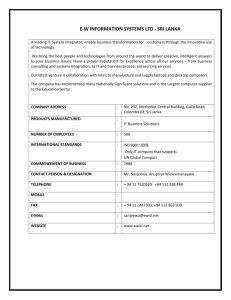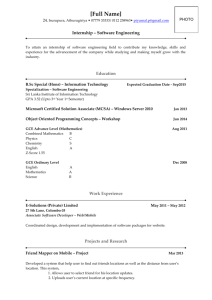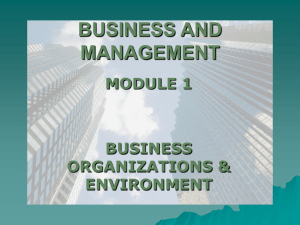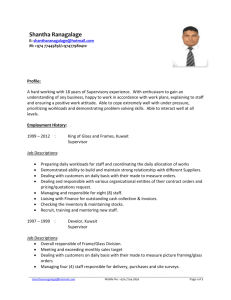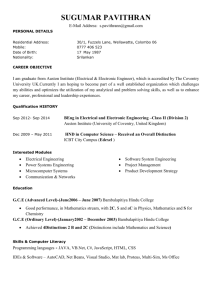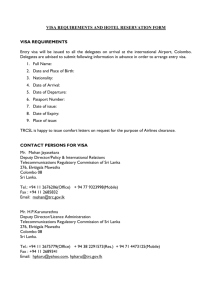Economic activity
advertisement
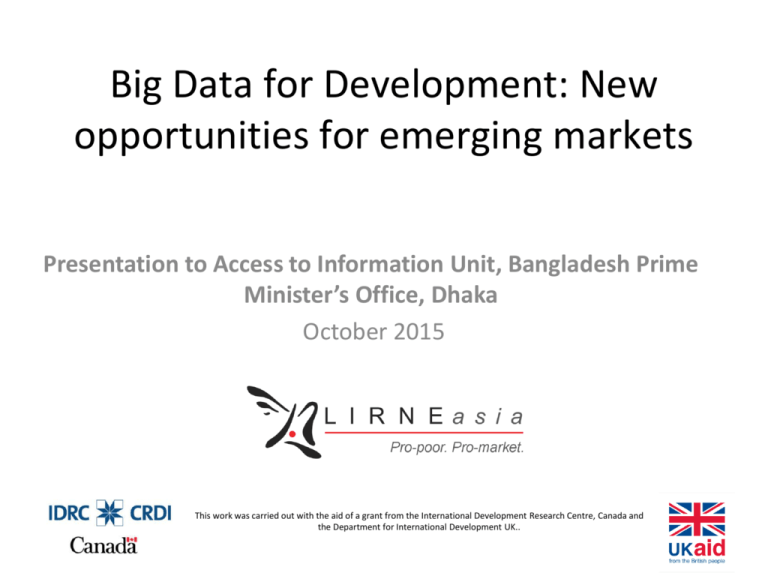
Big Data for Development: New opportunities for emerging markets Presentation to Access to Information Unit, Bangladesh Prime Minister’s Office, Dhaka October 2015 This work was carried out with the aid of a grant from the International Development Research Centre, Canada and the Department for International Development UK.. What kinds of comprehensive big data are available in emerging economies? • Administrative data – E.g., digitized medical records, insurance records, tax records • Commercial transactions (transaction-generated data) – E.g., Stock exchange data, bank transactions, credit card records, supermarket transactions connected by loyalty card number • Sensors and tracking devices – E.g., road and traffic sensors, climate sensors, equipment & infrastructure sensors, mobile phones communicating with base stations, satellite/ GPS devices • Online activities/ social media – E.g., online search activity, online page views, blogs/ FB/ twitter posts 2 Currently only mobile network big data satisfies criterion of broad population coverage Mobile SIMs/100 Internet users/100 Facebook users/100 Myanmar 13 1 4 Bangladesh 67 7 6 Pakistan 70 11 8 India 71 15 9 Sri Lanka 96 22 12 Philippines 105 39 41 Indonesia 122 16 29 Thailand 138 29 46 Source: ITU Measuring Information Society 2014; Facebook advantage portal 3 Mobile network big data + other data rich, timely insights that serve private as well as public purposes Mobile network big data (CDRs, Internet access usage, airtime recharge records) Construct Behavioral Variables 1. Mobility variables 2. Social variables 3. Consumption variables Other Data Sources 1. Data from Dept. of Census & Statistics 2. Transportation data 3. Health data 4. Financial data 5. Etc. Dual purpose insights Private purposes Public purposes 1. Mobility & location based services 2. Financial services 3. Richer customer profiles 4. Targeted marketing 5. New VAS 1. Transportation & Urban planning 2. Crises response + DRR 3. Health services 4. Poverty mapping 5. Financial inclusion 4 Data used in the research • Multiple mobile operators in Sri Lanka have provided four different types of meta-data – Call Detail Records (CDRs) • Records of calls • SMS • Internet access – Airtime recharge records • Data sets do not include any Personally Identifiable Information – All phone numbers are pseudonymized – LIRNEasia does not maintain any mappings of identifiers to original phone numbers • Cover 50-60% of users; very high coverage in Western (where Colombo the capital city in located) & Northern (most affected by civil conflict) Provinces, based on correlation with census data 5 Actions to improve data sharing • Reduce transaction costs – Guidelines on managing privacy and competitive implications developed; being consulted with experts and stakeholders • Language can be used in non-disclosure agreements – Work ongoing to reduce pseudonymization burdens to companies 6 Work performed by collaborative interdisciplinary teams • LIRNEasia – – – – – – – Sriganesh Lokanathan Kaushalya Madhawa Danaja Maldeniya Prof. Rohan Samarajiva Dedunu Dhananjaya Madhushi Bandara Nisansa de Silva (moved on to U of Oregon) • LIRNEasia/ MIT – Gabriel Kreindler (Economics) – Yuhei Miyauchi (Economics) • Other US Universities – Prof. Joshua Blumenstock (U Washington, School of Information) • Data Science – Saad Gulzar (NYU Poli Sci) • • Political Science University of Moratuwa – Prof. Amal Kumarage • Transport – Dr. Amal Shehan Perera • Data Mining – Undergraduates working on projects • Advisors: – Dr. Srinath Perera (WSO2) – Prof. Louiqa Rashid (U of Maryland) 7 Illustrative findings • Understanding population density & mobility – Population density – Commuting patterns: where do people live and work – Mobility changes during important events: Case study of “Avurudu” • • • • Understanding land use characteristics Understanding communities Preliminary work on gaining insights on economic activity Exploratory work on gaining insights from reload data 8 • Understanding population density & mobility – Population density – Commuting patterns: where do people live and work – Mobility changes during important events: Case study of “Avurudu” • • • • Understanding land use characteristics Understanding communities Preliminary work on gaining insights on economic activity Exploratory work on gaining insights from reload data 9 Population density changes in Colombo region: weekday/ weekend Weekday Pictures depict the change in population density at a particular time relative to midnight Time 12:30 Time 18:30 Sunday Time 06:30 Decrease in Density Increase in Density 10 Population density changes in Jaffna & Kandy regions on a normal weekday Pictures depict the change in population density at a particular time relative to midnight Jaffna Time 06:30 Time 12:30 Time 18:30 Kandy Decrease in Density Increase in Density 11 Our findings closely match results from expensive & infrequent transportation surveys 12 MNBD data can give us granular & high-frequency estimates of population density DSD population density from 2012 census DSD population density estimate from MNBD Voronoi cell population density estimate from MNBD 13 • Understanding population density & mobility – Population density – Commuting patterns: where do people live and work – Mobility changes during important events: Case study of “Avurudu” • • • • Understanding land use characteristics Understanding communities Preliminary work on gaining insights on economic activity Exploratory work on gaining insights from reload data 14 46.9% of Colombo City’s daytime population comes from the surrounding regions Colombo city is made up of Colombo and Thimbirigasyaya DSDs Home DSD %age of Colombo’s daytime population Colombo city 53.1 1. Maharagama 3.7 2. Kolonnawa 3.5 3. Kaduwela 3.3 4. Sri Jayawardanapura Kotte 2.9 5. Dehiwala 2.6 6. Kesbewa 2.5 7. Wattala 2.5 8. Kelaniya 2.1 9. Ratmalana 2.0 10. Moratuwa 1.8 15 • Understanding population density & mobility – Population density – Commuting patterns: where do people live and work – Mobility changes during important events: Case study of “Avurudu” • • • • Understanding land use characteristics Understanding communities Preliminary work on gaining insights on economic activity Exploratory work on gaining insights from reload data 16 People travel greater distances during major holiday Average: 11.6km A-4 A-3 A-2 A-1 A A+1 A+2 A+3 A+4 17 More people travel greater distances during “Avurudu” A -1 A A +1 18 Net inflow during Avurudu weekend With the exception of Ampara, more Colombo city residents travelled to other DSDs during Avurudu, as compared to other weekends (some examples below): • • • • • • • • • • Nuwara Eliya: 315% Kotmale: 233% Town & Gravets (Trincomalee): 100% Udunuwara: 93% Kalutara: 90% Jaffna: 80% Galle Four Gravets: 77% Gangawata Korale: 71% Attanagalla: 71% Mirigama: 66% 19 Implications for public policy • Population maps and mobility/migration patterns are essential policy tools – Included in most census and household surveys • MNBD allows us to improve & extend measurement – Large sample sizes – Very frequent measurement • More precise measures – Commuting/ seasonal/ long-term migration 20 Implications for public policy • Improve planning for “spiky” events that create pressure on government and privately supplied services – Humanitarian response to disasters – Special events/holidays • Urban & transportation planning – Can identify high volume transport corridors to prioritize for provision of mass transit – Map de facto municipal boundaries • Health policy – Mobility patterns that can help respond to spread of infectious diseases (e.g., dengue) 21 • Understanding population density & mobility – Population density – Commuting patterns: where do people live and work – Mobility changes during important events: Case study of “Avurudu” • • • • Understanding land use characteristics Understanding communities Preliminary work on gaining insights on economic activity Exploratory work on gaining insights from reload data 22 Hourly loading of base stations reveals distinct patterns Type X: ? Type Y: ? • We can use this insight to group base stations into different groups, using unsupervised machine learning techniques 23 Methodology • The time series of users connected at a base station contains variations, that can be grouped by similar characteristics • A month of data is collapsed into an indicative week (Sunday to Saturday), with the time series normalized by the z-score • Principal Component Analysis(PCA) is used to identify the discriminant patterns from noisy time series data • • Each base station’s pattern is filtered into 15 principal components (covering 95% of the data for that base station) Using the 15 principal components, we cluster all the base stations into 3 clusters in an unsupervised manner using k-means algorithm 24 Three spatial clusters in Colombo District • Cluster-1 exhibits patterns consistent with commercial area • Cluster-3 exhibits patterns consistent with residential area • Cluster-2 exhibits patterns more consistent with mixed-use 25 Our results show Central Business District (CBD) in Colombo city has expanded 26 Small area in NE corner of Colombo District classified as belonging to Cluster 1? Photo ©Senanayaka Bandara - Panoramio Seethawaka Export Processing Zone 27 Internal variations in mixed use regions: More commercial or more residential? • To evaluate the relative closeness to the other two clusters, we define extent of commercialization as: Blue dots: more residential than commercial Red dots: more commercial than residential28 Plans & reality 1985 Plan 2020 UDA Plan 2013 reality 29 Implications for urban policy • Almost real-time monitoring of urban land use – We are currently working on understanding finer temporal variations in zone characteristics (especially the mixed-use areas) • Can complement infrequent surveys & align master plan to reality • LIRNEasia is working to unpack the identified categories further, e.g., – Entertainment zones that show evening activity 30 • Understanding population density & mobility – Population density – Commuting patterns: where do people live and work – Mobility changes during important events: Case study of “Avurudu” • • • • Understanding land use characteristics Understanding communities Preliminary work on gaining insights on economic activity Exploratory work on gaining insights from reload data 31 Prima facie, Colombo city (Colombo & Thimbirigasyaya DSDs) seems to be the center of Sri Lanka’s social network • Each link represents the raw number of outgoing and incoming calls between two DSDs • Divisional Secretariat Division (DSD) is a third level administrative division; 331 in total in LK Low High No. of calls 9 A different picture emerges when call volume is normalized by population ● Strongly connected regional networks become visible Low High No. of calls 10 Identifying communities: methodology • The social network is segregated such that overlapping connections between communities are minimized • Strength of a community is determined by modularity • Modularity Q = (edges inside the community) – (expected number of edges inside the community) M. E. J.-Newman, Michele-Girvan, “Finding and evaluating community structure in networks”, Physical Review E, APS, Vol. 69, No. 2, p. 1-16, 204. 12 We find Sri Lanka is made up of 11 communities 35 How do communities match existing administrative divisions? The 11 detected communities The 9 provinces 36 With some exceptions, boundaries of communities differ from existing administrative divisions • Northern (1), Uva (10) and Southern (11) communities most similar to existing provincial boundaries; but 11 takes Embilipitiya and Kataragama • Colombo district is clustered as a single community (7) • Gampaha merges with coastal belt of North Western Province (2) and Kalutara (8) is its own community – What does this mean for Western Province Megapolis? • Batticaloa & Ampara districts of the Eastern Province merge with the Polonnaruwa district of North Central Province to form its own distinct community (6) – Possibly reflective of economic linkages since this is the rice belt of Sri Lanka – Does economics override ethnicity? 37 More differences appear when we zoom in further • The littoral regions form their own distinct subcommunities • The northern part of Colombo city forms a community with Wattala, across the Kelani river • In general, rivers no longer form natural boundaries of communities Bridge 38 • Understanding population density & mobility – Population density – Commuting patterns: where do people live and work – Mobility changes during important events: Case study of “Avurudu” • • • • Understanding land use characteristics Understanding communities Preliminary work on gaining insights on economic activity Exploratory work on gaining insights from reload data 39 How is mobility informative about economic activity? Economic activity = (number of workers) x (productivity per worker) Observed Must be inferred •We assume more productive regions are more attractive destinations •Commuting patterns emerge from the trade-off between attractiveness of a workplace and the cost of getting there 40 Example of commuting flows from one origin location Biyagama Export Processing Zone 41 Theoretical model outline 42 Economic activity/km2 Low High 43 Model validation using nightlight data from satellites Nightlights Low Mean income High 44 Incorporating other data can give further insights Household data: Census/HIES/LFS Industrial data: ASI, Industrial Census Nightlights Household data Industrial Data yearly quarterly/ 2-3yrs/decade yearly/decade Education, (un)employment, skill levels Employment, capital intensity Improving Measure Improving & Validation Geographic variation Time variation Relevant variables Ideal for: 45 Benefit of an improved framework for modeling economic activity • Increase the coverage of existing surveys (both temporal and geographic) – By calibrating with household, industry census and survey data, when available – Then, mobile data can be used to predict/extrapolate for time periods and regions without survey data • Can capture informal economic activity – Other research suggests informal economy is almost 30% of GDP in Sri Lanka 46 Implications •A new measure of economic activity from commuting flows (from mobile phone data) •Significant potential use for policy and research. •Fine temporal and spatial resolution. •Preliminary validation with the best available data looks promising •Additional data (Industrial, Household) will allow measure to be taken to next level 47 • Understanding population density & mobility – Population density – Commuting patterns: where do people live and work – Mobility changes during important events: Case study of “Avurudu” • • • • Understanding land use characteristics Understanding communities Preliminary work on gaining insights on economic activity Exploratory work on gaining insights from reload data 48 Average monthly reload by residents of Colombo & adjacent region is high, as is variability Average monthly reload amount Co-efficient of Variation (COV) Low High 49 Similar story for Northern Province residents, but average monthly reload is higher than Colombo district Average monthly reload amount Low Co-efficient of Variation (COV) High 50 Research in other countries suggest differential reload behavior may be correlated to household income Higher household income Average top-up size 10 Lower household income 1 1 1 1 1 1 1 1 1 1 Top-up frequency Source: Gutierrez, T., Krings, G., & Blondel, V. D. (2013). Evaluating socio-economic state of a country analyzing airtime credit and mobile phone datasets, 1–6. Retrieved from http://arxiv.org/abs/1309.4496 But preliminary LK results are inconclusive • Large majority of LK mobile users reload using recharge cards and higher denomination cards are not easy to come by • High reload spending in Northern Province meshes with – Findings from Department of Census and Statistics – LIRNEasia research on high communication expenditures • Addition work required: – Ideally we would have user-level socio-economic data through phone surveys, but difficult to implement – Co-relate fine grained MNBD behavioral data (not just reload but also mobility and social) with census-block level data from HIES and Census • V. Soto, V. Frias-Martinez, J. Virseda, and E. Frias-Martinez. 2011. Prediction of socioeconomic levels using cell phone records. In Proceedings of the 19th International Conference on User Modeling, Adaption, and Personalization (UMAP’11). Springer-Verlag, Berlin, 377–388 52 Selected Publications & Reports • • • • • • Lokanathan, S., Kreindler, G., de Silva, N. D., Miyauchi, Y., Dhananjaya, D., & Samarajiva, R. (forthcoming). Using Mobile Network Big Data for Informing Transportation and Urban Planning in Colombo. Information Technologies & International Development Samarajiva, R., Lokanathan, S., Madhawa, K., Kriendler, G., & Maldeniya, D. (2015). Big data to improve urban planning. Economic and Political Weekly, Vol L. No. 22, May 30 Maldeniya, D., Lokanathan, S., & Kumarage, A. (2015). Origin-Destination matrix estimation for Sri Lanka using mobile network big data. 13th International Conference on Social Implications of Computers in Developing Countries. Colombo Kreindler, G. & Miyauchi, Y. (2015). Commuting and Productivity: Quantifying Urban Economic Activity using Cell Phone Data. LIRNEasia Lokanathan, S & Gunaratne, R. L. (2015). Mobile Network Big Data for Development: Demystifying the Uses and Challenges. Communications & Strategies. Lokanathan, S. (2014). The role of big data for ICT monitoring and for development. In Measuring the Information Society 2014. International Telecommunication Union. More information: http://lirneasia.net/projects/bd4d/ 53
